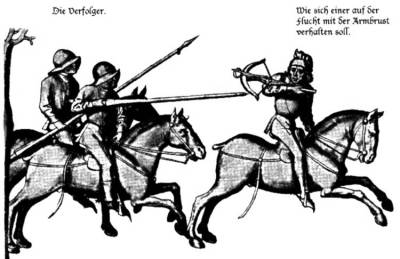Gerichtliche und andere Zweikampfe darstellend
Anno Domini 1467
Hans Talhoffer
VS-Books, 1998, isbn 3-932077-03-2
an English translation is now finally available!
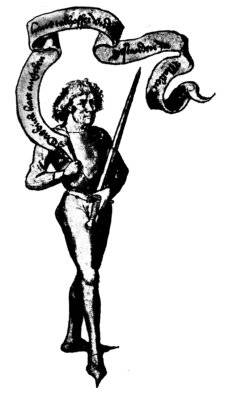
the author
Talhoffers Fechtbuch is an illustrated manual for judicial and other duels, composed in 1467. It contains 268 plates (tafels) with short descriptions. This print reproduces an edition from 1887 by Gustav Hergsell. The introduction, which gives a short history of fencing literature, is also his. The introduction isn't uninteresting, but is completely unrelated to the technical content of the Fechtbuch. If your German skill is poor or non-existant, you won't miss much by skipping the introduction.
Each plate is represented on a full page in landscape orientation. The illustrations are crisp and clean. On the other hand, the paper used is not very high quality and in a rather annoying yellow color. I regret that the beautiful calligraphy of the original was removed. The captions are taken from Hergsell and printed in some kind of fraktur font. Undoubtedly this improves legibility, but in my opinion there remained sufficient free space on each page to retain the original captions as well. The printed text just hasn't the same artistic quality. Hergsell's captions also don't preserve the verse of the original. The editors suggest that Hergsell made several mistakes in copying the figures or captions, but apparently they didn't attempt to correct those.
This is not an easy book to understand. A lot of information is crammed in each drawing, the captions are very short, and there are no little arrows to indicate movement. The weapons magically change in length between plates to accommodate the distance between the combatants. There is no introduction explaining the target audience, presumed skill level, or place of the work in the master's curriculum. I had to go through it several times before I started to get into the style of presentation and could understand some of the techniques. But by now I'm convinced it is possible to understand a lot of the techniques from the book. It was actually quite exciting to perform a technique from a manual more than 500 years old.
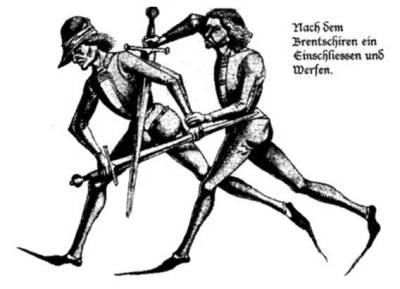
The first chapter deals with the long sword (Langes Schwert). This is used in a great variety of ways and was probably the base for the entire system, but unfortunately it is also the most difficult to understand (for me). This long sword was very versatile and could be used to cut, thrust, trip, lock, throw and bash (holding the blade with both hands, too!). I'm not even sure what kind of sword it is exactly (due to the changing length in the drawings). It is wielded with two hands, and the length of the grip seems to allow at least the width of a hand between both hands on some drawings. The section on armoured combat shows one knight wearing the sword on the hip (I don't think this would work with a 60inch sword), and in later sections a sword used in one hand is drawn with a very similar hilt, so maybe it's actually a poorly drawn hand-and-a-half or bastard sword.
Concerning gripping the blade: some believe this means the swords were unsharpened, others believe the fighters wore reinforced gauntlets. The first idea seems improbable, but there are no gauntlets in the drawings.
In his book on medieval swordsmanship, John Clements suggests the drawings in this chapter represent men training with blunts and the reader should imagine the armour and gloves. However, this doesn't seem likely since there is another chapter on fighting in full gear (voller Rustung). In the judicial duels, combatants are drawn wearing the special trial outfit. There is no justification for only this one chapter to appeal to the reader's imagination. Also, with all the blood and gore and fatal injuries depicted, it looks like a funny way to train.
To settle the matter I took my spring steel tameshigiri-to (japanese style sword for cutting practice), grabbed it with both hands and swung it around some, then bashed with the tsuba (guard) on the tatami (mat) a few times (in the direction of the flat side of the blade). I'm still typing and didn't loose a drop of blood. I don't suggest kids should try this at home though. The biggest risk I think is that you forget where the sword tip is and stab yourself.
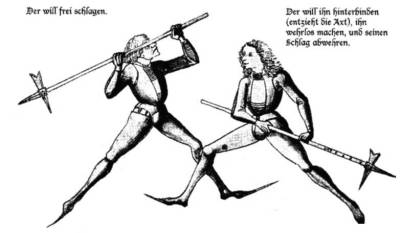
Streitaxt is a pole-axe or pole-hammer, a bo-length staff gripped mostly in the middle, with a head that consists of a spike, a beak and a pronged hammer or axe. Both ends are used to strike and thrust or to defend, and the beak and axe can be used to hook. As with the long sword, there are also close range grappling moves in this chapter.
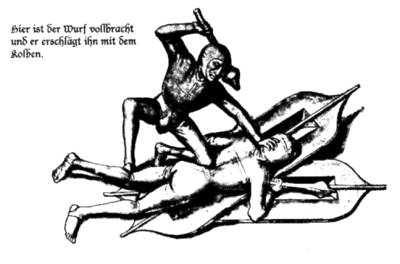
Schild und Kolben (shield and club) is a Frankish style trial by combat. The shield is a huge rectangular affair with a staff running along the back functioning as a grip, whose protruding pointy ends can be used to stab. The main tactic seems to be to bring your own shield between the opponent's and himself, so he becomes unprotected. In the judicial duel the participants wear a tight outfit with a cap, that according to Hutton was leather, sewn on the person, and smeared in grease. I suppose this precludes any last minute trip to the restroom...
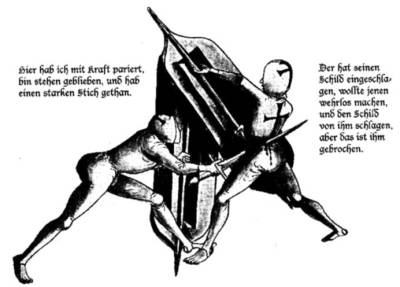
The Swabish judicial duel uses a sword instead of a club. Various techniques are also shown with the shield as only weapon. Some of these shields are hooked and the hooks are used to catch the opponent's extremities.
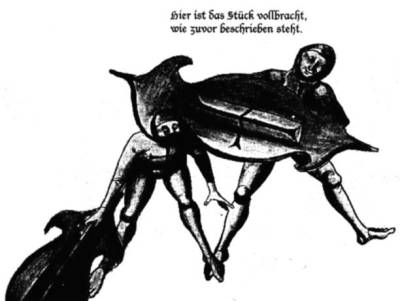
The Degen is a rondel dagger, the standard 15th century military backup weapon. It is about 40cm overall, triangular blade with a round handguard. Such a dagger was used to stab through armour. There are two attacks, a low stab and a reverse grip downward stab. The defenses look strange but are surprisingly effective. I have practiced some techniques from this section with a few friends (we don't have substitute weapons for the other chapters yet).
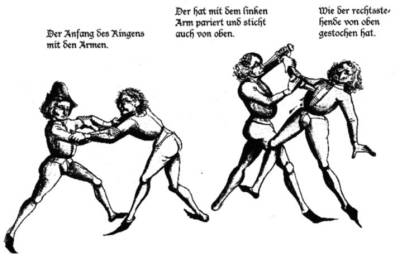
Unarmed fighting is called Ringen and consists mostly of throws by balance disruption or joint manipulation. Some techniques stretch over more than one Tafel, which is occasionally confusing when they continue on the right instead of the left side of the tafel. Counters are given to certain moves, or the counter is integrated in the main drawing (for example, the loser might be depicted as making a grab to the winner's groin while being thrown).
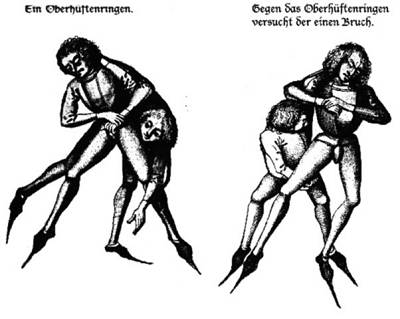
an armlock and the counter
The captions can be helpful to connect a sequence of related drawings, but most of the time they contain little information that isn't found in the drawings. An example (not shown here): "das heisst ein Bubenringen" = "this is called a -technique name-" something looking like judo tomoe nage. The opposite drawing: "der Bruch dagegen: falle mit dem Knie in seine Macht" = "the counter to this: drop with the knee on his manhood." Not overly complicated, right? Additionally, an english translation of (another version of ) the captions is made available by the HACA.
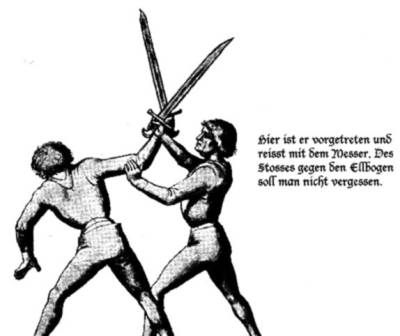
Messer seems to mean a single hand sword, in this chapter it is a single-edged falchion with clip point and ring guard, but in the next chapter, Messer und kleiner Schild (buckler), a "normal" double edged sword is drawn. Einer gegen zwei (1 against 2) is a short bit, showing a short dagger (Dolch) in the same hand as the buckler.
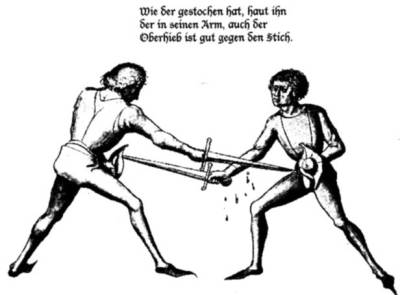
The next chapter shows a judicial duel between husband and wife. The man has a club and stands in a hole up to his waist as a handicap. The woman has a sling, a 5lb stone in a sock, as weapon, and is also dressed in tight leather (those naughty middle agers!). Talhoffer gives advice to the woman too (so were there women in his school or among his readers?).
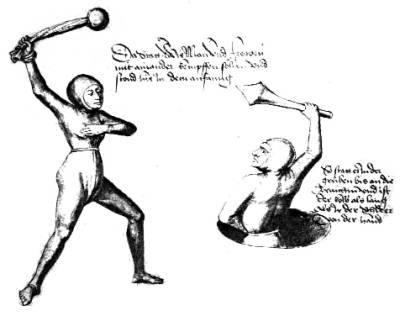
this is a scan from the original, note the much cooler calligraphy
The next four chapters deal with fighting on horseback, with sword, Spiess, unarmed and with the Armbrust (crossbow).
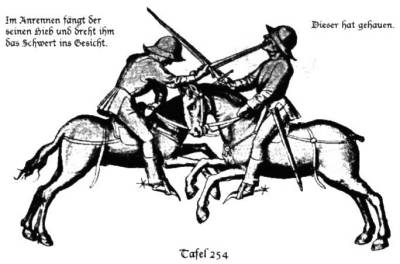
This is a very interesting book, even if you're not fluent in german (it's only my fourth language and I never was very good at German medieval martial terminology in school either). If you thought that well-developed systems of combat existed only in Asia, you should certainly read this book (or look at the pictures).
